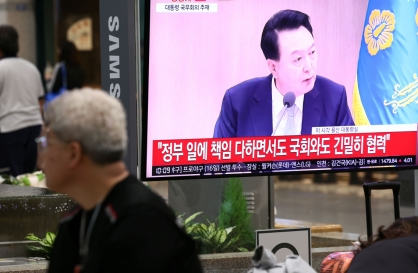[Kim Myong-sik] Insatiable ‘historians,’ enough is enough
By Kim Myong-sikPublished : May 22, 2019 - 17:14
 Korea today has an abundant supply of photo artists, poets and historians.
Korea today has an abundant supply of photo artists, poets and historians. New smartphones are equipped with high-definition cameras of 12 to 16 megapixels, which can produce great pictures. But our amateur photographers, many of whom are old, need something different. They go about on city streets, mountains and seashores carrying branded cameras -- the digital version -- with long lenses and even tripods to take thousands of shots of anything within their sight.
Poets, of course self-styled, may be less numerous than photographers, but their number has grown significantly. I have yet to read a convincing analysis of our social conditions that provide fertile grounds for poets rather than prose writers, yet at least three of my close friends have chosen poetry as the main pursuit of life after retirement.
On subway platforms, we can see poems in white paint on the sliding glass doors, some trying to convey incomprehensible ideas with abstract words, but others with a fine emotional appeal guide readers to the nostalgia of old homes or to the sensitivity of departing from loved ones. These works have been selected by Seoul City Hall through open contests of aspiring poets that might include my friends.
The third group of people who vow to straighten up distorted history has emerged outside the ivory towers. They are from the political community, civic organizations and secondary media, which includes online newspapers, podcasts and social media with large followings. Politically motivated in general, these new breed of historians delve into the darker periods of the nation, but drawing conclusion is not their job.
They focus on the role of the government-in-exile in Shanghai, massacre of peasants on Jeju Island in 1947, hidden facts about the Gwangju Uprising in 1980, etc. Another area of their scrutiny is the final years of the Japanese colonial occupation of Korea, aimed at picking up notable citizens who helped colonial authorities in their war efforts.
Numerous well-known people who have made meritorious services in the areas of arts and education are condemned as traitors if the self-appointed judges find any records revealing their succumbing to pressures from the Japanese authorities. Their sins are making public calls to youths to join the Japanese army or writing pieces to a similar effect. Among them are many notables who joined in founding the Republic of Korea in cooperation with nationalist (anti-communist), right-wing leaders.
Seventy-four years after liberation, some left-wing activists are still engrossed in the purge of “Japan sympathizers,” wielding a “Who’s Who of Traitors.”
Take the example of Lee Heung-ryeol (1909-1980), composer of school songs for many high schools and colleges, whose name is listed in the three-volume book for having played the piano in official events as a member of the Joseon Music Association in 1941-45.
School authorities and the alumni society of my alma mater, Gwangju First High, recently decided to change the school song for the sole reason that it was composed by Lee, rejecting objections from older graduates. Similar nonsensical rows are underway in many other schools in Seoul and provinces over the involvement of former pro-Japanese musicians and poets in making school songs -- in the post-liberation years.
Members of the National Affairs Research Institute, a private body that published the list, picked up alleged collaborators from various publications issued in the years between the Japanese annexation and liberation. You can find in the book almost all names of leading educators, musicians, painters, movie producers, directors and actors and journalists who were active in the final years of Japanese occupation.
Their historical surveys on colonial collaborators conducted during the 2000s may have some merits. What I miss is a balanced evaluation. Besides, what on earth is wrong with the short school song of Gwangju First High School which had been proudly sung by tens of thousands of boys for half a century? Should all my alumni have to share the blame for the song?
Gwangju City, famous for the anti-Japanese student movement in 1929, is the place where the nonacademic historians are most active in the country. For nearly four decades since the 1980 uprising against military control, private investigations continued by civil activists to supplement and corroborate what they believed insufficient results of official probes into the 10-day bloodshed. A new round of “comprehensive investigation” will soon be launched under a March 2018 truth law, assisted by local historians.
Twenty years earlier in 1960, there were similarly bloody acts of resistance by students against the dictatorship. Within a week, Rhee Syng-man’s 12-year rule was toppled and a democratic government was formed, which however was short-lived. In contrast, the Gwangju Uprising was crushed by the Army, generals who changed into civvies continued authoritarian rule for seven more years, and a supposedly democratic government that succeeded was led by a former general.
So, Gwangju had no chance of expeditiously divulging all truths, including the correct number of casualties. It was not until President Roh Tae-woo took office that a reconciliation commission was formed to determine what had really happened in the spring of 1980, and not until the Kim Young-sam administration that proper compensation of the victims started.
While Gwangju remained a symbol of dissent against the central government, there was ample room for the self-commissioned historians in Seoul and elsewhere to dig into facts which the military painted with lies and covered with news blackouts. In the following years, new claims of atrocities were handled by the law enforcement authorities, who even examined assertions of infiltration by North Korean agents to instigate violence.
The 39 years from 1980 are a long time. That period included the 10-year liberal rule of Kim Dae-jung and Roh Moo-hyun, which did not neglect finding facts and trying to relieve the pains of Gwangju citizens. Again on another anniversary this year, we see repetitive media debates on allegations of rapes by soldiers, secret burial of bodies and machinegun strafing from helicopter(s) hovering over demonstrators. Activists call for further punishment of historical criminals based on “new findings.”
In South Korea 2019, we can put up with the apparently overpopulated poets and photo artists whose works may improve as time goes. To our insatiable historians, we plead: Enough is enough.
Kim Myong-sik
Kim Myong-sik is a former editorial writer for The Korea Herald. – Ed.






![[From the Scene] Monks, Buddhists hail return of remains of Buddhas](http://res.heraldm.com/phpwas/restmb_idxmake.php?idx=644&simg=/content/image/2024/04/19/20240419050617_0.jpg&u=20240419175937)







![[From the Scene] Monks, Buddhists hail return of remains of Buddhas](http://res.heraldm.com/phpwas/restmb_idxmake.php?idx=652&simg=/content/image/2024/04/19/20240419050617_0.jpg&u=20240419175937)

![[KH Explains] Hyundai's full hybrid edge to pay off amid slow transition to pure EVs](http://res.heraldm.com/phpwas/restmb_idxmake.php?idx=652&simg=/content/image/2024/04/18/20240418050645_0.jpg&u=20240419100350)

![[Today’s K-pop] Illit drops debut single remix](http://res.heraldm.com/phpwas/restmb_idxmake.php?idx=642&simg=/content/image/2024/04/19/20240419050612_0.jpg&u=)